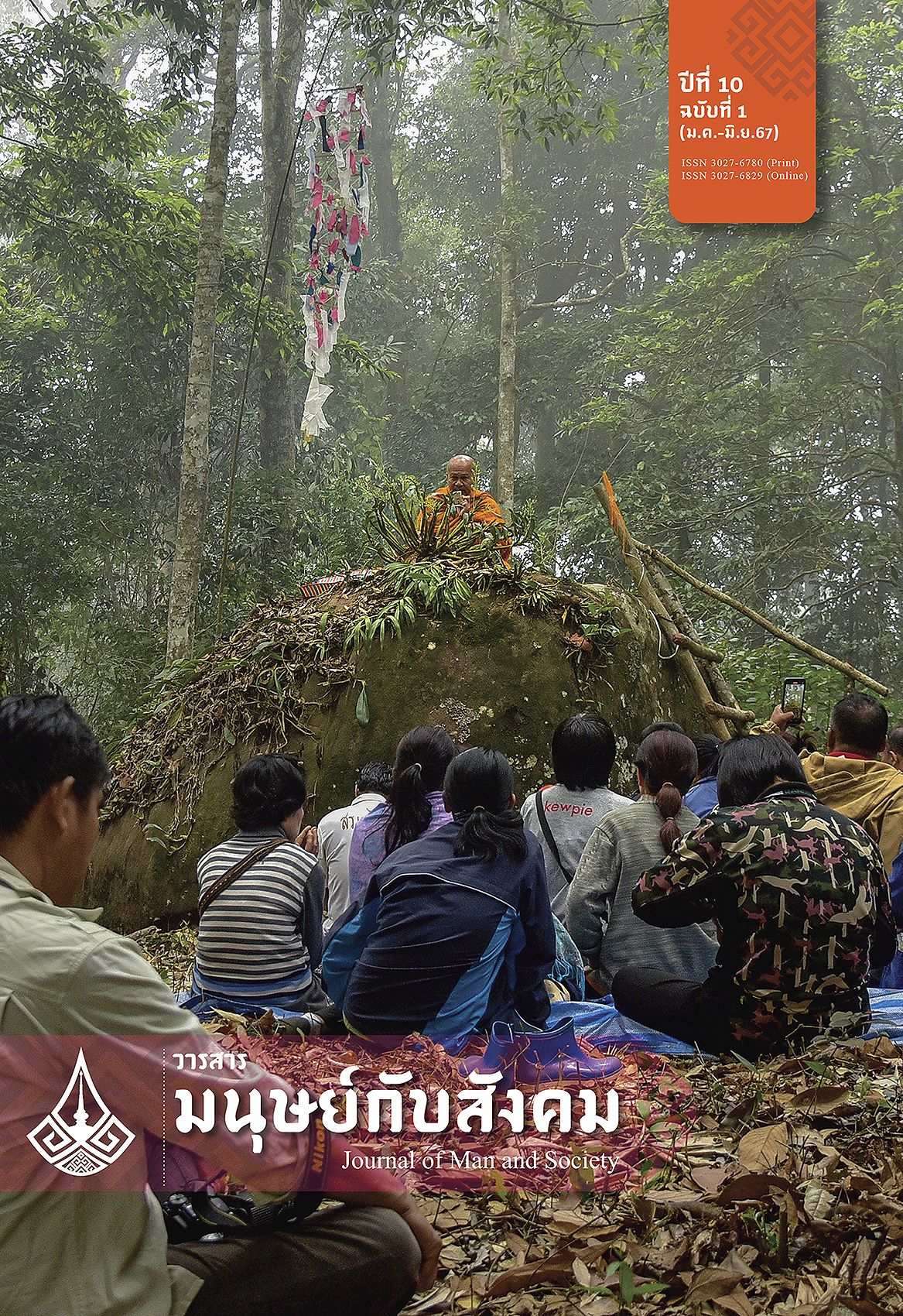A Study of the Gay Monk Identity: Case Study of Gay Monks in Chiang Rai
Main Article Content
Abstract
This study aimed to reveal the definitions of the current identity of gay monks along with the deconstruction process and construction of a new identity for gay monks within the monastic gender. This process arose from negotiations, fighting, and pushing with monks who had hegemonic masculinity in northern society. This study used postmodern feminist ethnographic research methodology through in-depth interviews. The mentioned interview had three main points of results. The first result showed that the definition of the identity of gay monks is the behavior of gay monks that is appropriate to the role, function and position. The second result showed that the identity construction of men in the northern region from their childhood was not required to work according to sex. Therefore, boys could help with housework. The concept of masculinity in society caused the devaluation of gay in a secular society; however, the status was changed in a monastic society where gay monks were praised and honored. The third result showed that gay monks negotiated and fought through the application of femininity, such as cleaning temples, adorning the place and teaching housewives in dance for the sake of Buddhism. However, Thai society still adhered to the negative stereotypes of gays. As a result, the status of gay monks was still inferior to that of monks who had a hegemonic masculinity. The result of the fourth study revealed that the identity of gay monks changed all the time. It depended on their role and status as a result of the learning process with the influence of masculinity in a monastic society. This was an invisible power that controlled gay monks and made them choose an identity for existence and survival in a society of masculinity.
Article Details

This work is licensed under a Creative Commons Attribution-NonCommercial-NoDerivatives 4.0 International License.
เนื้อหาและข้อมูลที่ตีพิมพ์ลงในวารสารมนุษย์กับสังคม ถือเป็นข้อคิดเห็นและความรับผิดชอบโดยตรงของผู้เขียนซึ่งกองบรรณาธิการวารสารไม่จำเป็นต้องเห็นด้วยหรือร่วมรับผิดชอบใดๆ
บทความ ข้อมูล เนื้อหา รูปภาพ ฯลฯ ที่ได้รับการตีพิมพ์ในวารสารมนุษย์กับสังคม ถือเป็นลิขสิทธิ์ของวารสาร หากบุคคลหรือหน่วยงานใดต้องการนำทั้งหมดหรือส่วนหนึ่งส่วนใดไปเผยแพร่ต่อต้องอ้างอิงวาสาร
References
กุลวีร์ ประภาพรพิพัฒน์. (2545). แนวคิดและจริยศาสตร์ที่เกี่ยวกับเพศในพุทธศาสนาเถรวาท [วิทยานิพนธ์ศิลปศาสตรมหาบัณฑิต, มหาวิทยาลัยธรรมศาสตร์]. Thammasat University Digital Collections. https://digital.library. tu.ac.th/tu_dc/frontend/Info/item/dc:116438
ฉลาดชาย รมิตานนท์. (2542). การศึกษาครอบครัวไทย: ข้อคิดและแนวทางการศึกษา. วารสารสังคมศาสตร์มหาวิทยาลัยเชียงใหม่, 11(2), 1-21.
ไชยรัตน์ เจริญสินโอฬาร. (2543). วาทกรรมการพัฒนา: อํานาจ ความรู้ ความจริง เอกลักษณ์ และความเป็นอื่น (พิมพ์ครั้งที่ 2 ฉบับปรับปรุง). ศูนย์วิจัยและผลิตตำรา มหาวิทยาลัยเกริก.
ไชยันต์ ไชยพร. (2546). ผู้หญิงกับความรู้ในประวัติศาสตร์ความคิดทางการเมืองตะวันตก: ว่าด้วยวาทกรรมแห่งอุปสรรคของความรักระหว่าง โซเฟีย กับโซเฟีย ?. สังคมศาสตร์ปริทัศน์สมาคมสังคมศาสตร์แห่งประเทศไทย, 19(1), 27-52.
นฤพนธ์ ด้วงวิเศษ. (2556). เพศหลากหลายในสังคมไทยกับการเมืองของอัตลักษณ์. วารสารสังคมศาสตร์ คณะสังคมศาสตร์ มหาวิทยาลัยเชียงใหม่, 25(2), 137-168.
บรรจบ บรรณรุจิ. (2547). บวช: ที่มา ความหมาย และอิทธิพล. วารสารอักษรศาสตร์ฉบับภาษาเทศในภาษาไทย คณะอักษรศาสตร์ จุฬาลงกรณ์มหาวิทยาลัย, 33(1), 119-139.
บัว ญาณสมฺปนฺโน, พระมหา. (2550). ประวัติพระอาจารย์มั่น ภูริทัตตะเถร. ชวนพิมพ์.
พลศักดิ์ จิรไกรศิริ. (2562). ความเชื่อในพุทธธรรม สถานภาพในสถาบันสงฆ์ และความเชื่อทางการเมืองของพระสงฆ์ไทย. วารสารมหาจุฬาวิชาการ มหาวิทยาลัยมหาจุฬาลงกรณราชวิทยาลัย, 6(1), 17-32.
พิสิฏฐ์ โคตรสุโพธิ์. (2560, 2 เมษายน). พระพุทธศาสนาในอาณาจักรล้านนา. Blogspot. http://phil-re4you.blogspot.com/2017/04/blog-post_2.html
พิศิษฎ์ คุณวโรตม์. (2545). อัตลักษณ์และกระบวนการต่อสู้เพื่อชีวิตของผู้ติดเชื้อ HIV. สำนักงานคณะกรรมการส่งเสริมวิทยาศาสตร์ วิจัย และนวัตกรรม. Thammasat University Digital Collections. https://digital.library. tu.ac.th/tu_dc/frontend/Info/item/dc:84806.
มหาวิทยาลัยมหาจุฬาลงกรณราชวิทยาลัย. (2539). พระไตรปิฎกฉบับภาษาไทย ฉบับมหาจุฬาลงกรณราชวิทยาลัย. โรงพิมพ์มหาจุฬาลงกรณราชวิทยาลัย.
วชิรญาณวโรรส, สมเด็จพระมหาสมณเจ้า กรมพระยา. (2515). อุปสมบทวิธี และบุรพกิจสำหรับภิกษุใหม่ (พิมพ์ครั้งที่ 20). โรงพิมพ์มกุฎราชวิทยาลัย.
วิถี พานิชพันธ์. (2548). วิถีล้านนา. สำนักพิมพ์ซิลค์เวอร์ม.
วิริยังค์ สิรินฺธโร, พระ. (2521). ประวัติพระอาจารย์มั่น ภูริทตฺตเถระฉบับสมบูรณ์ และใต้สามัญสำนึก. อาทรการพิมพ์.
สมมอมรพันธุ์, พระเจ้าบรมวงศ์เธอ กรมพระ. (2545). เรื่องตั้งพระราชาคณะผู้ใหญ่ในกรุงรัตนโกสินทร์ เล่ม 1. กรมศิลปากร.
สักชาย กนฺตสีโล, พระมหา. (2551). การศึกษาวิเคราะห์เรื่อง “บัณเฑาะก์” ในกลุ่มพระภิกษุสามเณรไทยในปัจจุบัน [วิทยานิพนธ์ศิลปศาสตรมหาบัณฑิต, มหาวิทยาลัยธรรมศาสตร์]. Thammasat University Digital Collections. https://digital.library.tu.ac.th/tudc/frontend/Info/item/dc:125671
สุชาดา ทวีสิทธิ์. (2549). ชาติพันธุ์นิพนธ์แนวสตรีนิยม: การท้าทายกระบวนทัศน์ปฏิฐานนิยม. มหาวิทยาลัยเชียงใหม่.
สุวัฒน์ ปัญจวงศ์. (2560, 23 กุมภาพันธ์). จากเด็กม้งสู่บัลลังก์ท่านเปา “วิริยะบัณฑิต คีรีธะกุล”. มติชน, https://www.matichon.co.th/local/crime/news_474252
สุวิทย์ ไพทยวัฒน์, ไพฑูรย์ มีกุศล, และ พงษ์สวัสดิ์ สวัสดิ์พงษ์. (2541). พฤติกรรมมนุษย์ (พิมพ์ครั้งที่ 4). มหาวิทยาลัยสุโขทัยธรรมาธิราช.
อดุลย์ ยโสธโร, พระมหา. (2549). เรื่องการศึกษาเชิงวิเคราะห์เรื่องบัณเฑาะก์กับการบรรลุธรรม [วิทยานิพนธ์พุทธศาสตรมหาบัณฑิต, มหาวิทยาลัยมหาจุฬาลงกรณราชวิทยาลัย]. ฐานข้อมูลวิทยานิพนธ์และงานวิจัยอิเล็กทรอนิกส์ มหาวิทยาลัยมหาจุฬาลงกรณราชวิทยาลัย วิทยาเขตเชียงใหม่ & วิทยาเขตพะเยา. http://202.28.109.103/ethesis/mcu-4-49051.pdf
อรุโณทัย ปันศิริ. (2544). อัตลักษณ์ที่สร้างขึ้นบนโฮมเพจของวัยรุ่นไทยที่อาศัยอยู่ในบริบทสังคมไทยและวัยรุ่นไทยที่อาศัยอยู่ในบริบทสังคมอเมริกัน [วิทยานิพนธ์ปริญญานิเทศศาสตรมหาบัณฑิต, จุฬาลงกรณ์มหาวิทยาลัย]. ฐานข้อมูลวิทยานิพนธ์ไทย. http://thaithesis.org/detail.php?id=1082544001312#
อานันท์ กาญจนพันธุ์. (2560). ประวัติศาสตร์สังคมล้านนา: ความเคลื่อนไหวของชีวิตและวัฒนธรรมท้องถิ่น (พิมพ์ครั้งที่ 2). รัตนสุวรรณการพิมพ์.
Connell, R. W. (1992). A Very Straight Gay: Masculinity, homosexual Experience, and The Dynamics of Gender. American Sociological Review, 57(6), 735-751. https://doi.org/10.2307/2096120
Connell, R. W. (2005). Masculinities (2nd ed.). University of California Press.
Falk, M. L. (2007). Making the Field of Merit: Buddhist Female Ascetic and Gendered Orders in Thailand. NIAS.
Faure, B. (1998). The Red Thread: Buddhist Approaches to Sexuality. Princeton University Press.
Foucault, M. (1978). La Volenté de Savoir [The History of Sexuality, Volume 1: An Introduction]. Vintage Books.
Foucault, M. (1980). Power/ Knowledge: Selected Interviews and Other Writing 1972-1977. In Colin Gordon (Ed.). Pantheon Books.
Jackson, P. A. (1998). Male Homosexuality and Transgenderism in the Thai Buddhist Trandition. In W. Leyland (Ed.), Queer Dharma: Voices of Gay Buddhists (pp. 55-89). Gay Sunshine Press.
Jackson, P. A.(2003). Performative Genders, Perverse Desires: A Bio-History of Thailand’s Same Sex and Transgender Cultures. Intersections: Gender, History & Culture in the Asian Context, (9). http://intersections.anu.edu.au/issue9/jackson.html.
Khandelwal, M. (2004). Women in Ochre Robes: Gendering Hindu Renunciation. Sunny Press.
Rosalind, C. M. (1994). Three Sexes and Four Sexualities: Redressing the Discourse on Gender and Sexuality in Contemporary Thailand. Positions: Asia Critique, 2(1), 15-43.


